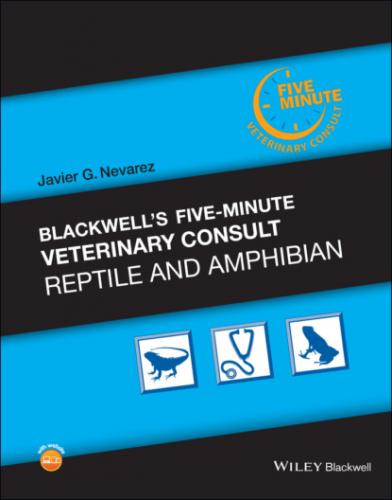The following endoparasites can be associated with diarrhea in tortoises:nematodes: oxyurids are very common in tortoises; ascarids are reported in wild‐ caught Testudo spp. (European tortoises) in captivity; other nematodes such as Strongyloides and Capillaria are uncommoncoccidia: uncommonciliated protozoa: Nyctotherus spp., Balantidium spp., Entamoeba spp. (E. invadens)flagellates: Trichomonas spp.
Bacteria: Proteus and Salmonella spp. are often asymptomatic carriers, but can lead to diarrhea.
SIGNALMENT/HISTORY
Diarrhea is more common in tortoises than in turtles.
Inappropriate husbandry: low environmental temperatures and overcrowding (stress) can lead to enteritis and diarrhea.
Inappropriate diet: tortoises fed a low‐fiber diet, high in fermentable sugars and protein, are prone to develop diarrhea.
Owners report liquid feces, frequently malodorous, with increased frequency of defecation.
Straining to defecate, anorexia, and cloacal prolapse may also be reported.
CLINICAL PRESENTATION
Depending on duration (acute vs. chronic), severity and etiology of diarrhea.
Fecal staining around cloaca, and ventral aspects of proximal hind limbs and tail base.
Presence of abnormally soft or liquid fecal matter in transport container.
Tortoises with diarrhea caused by an inappropriate diet might show no other clinical signs or may show unspecific clinical signs, such as lethargy, reduced food intake, or dehydration.
Chronic diarrhea can lead to weight loss and cachexia due to malabsorption of nutrients.
Cloacal tissue prolapse, such as rectal/distal colon prolapse, or true cloacal prolapse.
RISK FACTORS
Husbandry
In most tortoises (except red‐ and yellow‐ footed tortoises)—diet low in fiber and/or high in fermentable simple carbohydrates (e.g., fruits).
Change in diet
Poor sanitation can lead to high endoparasite load due to the direct lifecycle of many intestinal parasites of chelonians.
Overcrowding results in stress
Inappropriate (too low or too high) environmental temperatures.
Others
Wild‐caught animals often have a high endoparasite load and are often stressed during acclimatization to captivity.
Lack of fecal parasitology screening after acquisition.
DIFFERENTIAL DIAGNOSIS
Enteritis - bacterial, parasitic, dietary DIAGNOSTICS
DIAGNOSTICS
Fecal direct wet mount to evaluate for motile protozoa.
Fecal flotation to evaluate for helminths and protozoa (e.g., amoeba cysts).
Fecal cytology to rule out fungal infections
Diagnostic imaging (radiographs, CT, ultrasound) as needed.
Fecal bacterial cultures are rarely useful in the diagnosis and treatment of chelonians with diarrhea.
PATHOLOGICAL FINDINGS
Enteritis
Malodorous and liquid intestinal content
Emaciation
APPROPRIATE HEALTH CARE
N/A
NUTRITIONAL SUPPORT
Correct diet to ensure sufficient fiber intake in herbivorous tortoises.
Provide nutritional support to emaciated and/or anorexic animals.
Provide fluid therapy to dehydrated animals.
CLIENT EDUCATION/HUSBANDRY RECOMMENDATIONS
N/A
DRUG(S) OF CHOICE
Metronidazole: 40–100 mg/kg PO repeat 10–14 days or 25 mg/kg PO q24h for 5 days. Effective against motile protozoal organisms.
Emodepside/praziquantel (Profender®, Bayer DVM, Pittsburgh, PA): 1 ml/kg topical on skin. Repeat after 14 days. Effective against nematodes, trematodes and cestodes. Recommended in particular in animals that cannot be dosed orally. Animals should not be soaked for 24 hours after topical administration. Apply to skin around forelimbs and neck.
Fenbendazole: 20 mg/kg PO q24h for 3–5 days. Effective against nematodes and flagellates.
Pyrantel pamoate: 25 mg/kg PO q24h for 5 days, repeat in 3 weeks. Effective against nematodes including pinworms and ascarids.
Keep on newspaper until treatment is completed and recheck fecal samples.
Immediate removal of feces to prevent ingestion, bathing the tortoises, and cleaning of the pericloacal region to remove feces and eggs or cysts are strongly recommended.
Prevention of reinfection is critically important during and following treatment against parasites with a direct lifecycle.
PRECAUTIONS/INTERACTIONS
Fenbendazole has been shown to result in heteropenia and biochemical abnormalities in Testudo hermanni following administration of two courses of 50 mg/kg q24h for 5 days.
Fenbendazole has been shown in other reptiles to cause bone marrow suppression and temporary pancytopenia. Avoid doses > 20 mg/kg.
Do not use ivermectin or other macrocyclic lactones (e.g., selamectin) in chelonians.
PATIENT MONITORING
Return to normal fecal consistency.
Weight gain and maintenance of hydration.
Repeat fecal exams to ensure treatment effectiveness.
EXPECTED
